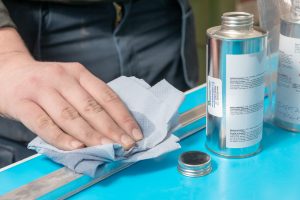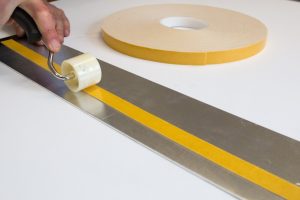Application Guide
To ensure you get the best bond and results from using our adhesive tapes, the application process is key to enable this. Yes, each application is different and needs to be treated so but the general application process remains the same.


Our Application Guide: Application Instruction Guide – 2021
Webpage link for our application products: https://www.ukindustrialtapes.co.uk/products/application-products/
Our 9-step guide as below:
- Temperature
As a general statement, the best temperature for bonding adhesive tapes is between +15°C and +30°C. Low temperature application is possible for modified adhesive systems, but there may be a compromise on the ultimate bond strength.
- Surface
The surface of the parts must be clean, dry and free of moisture and condensation. The surfaces must also be free of oil, fat, dust and other contaminants. Porous surfaces can be primed to ensure a uniform, stable surface.
- Application / Handling
When application of an adhesive tape is required by hand, Semi Automated or Fully Automated, it is vital that the adhesive is not touched at all prior to the adhesive tape being applied to the desired surface. If the Adhesive Tape is touched or handled before it is applied this will increase the potential levels of contaminations meaning oil’s, dirt & dust being transferred from fingers or hands onto the adhesive, it is crucial that this does not happen as this will affect the adhesive tapes overall bond.
- Cleaning
The cleaning of the surfaces has to be done with clean cloths together with suitable solvents like alcohol or ethers, to remove dust and oil. For release agents and other contaminants, you can use the following solvents: isopropanol water mixture 50:50, heptane, ethanol, acetone, MEK or other suitable solvents that do not attack the substrate to be bonded. The selected solvent must be checked thoroughly before being used and the safe use of solvents must always be taken into consideration.
- Primer
a)Our Prime LINK RS is an adhesion activator (cleaner & Activator in one) for a large number of different surfaces. Once applied it will clean the surface, it also alters the surface to make it more receptive to our adhesive tape systems. It works in a similar way to a chemical corona treatment. Prime LINK RS is particularly recommended for use with the following hard to adhere to surfaces: •Aluminium •Polished and unpolished stainless steel •Painted, zinc plated and chrome plated steel •Plastics: polyamide, polycarbonate, ABS etc •Powder coated substrates
Prime LINK RS can be used in conjunction with: Urethane adhesives, Epoxy adhesives and Acrylic adhesives. Prime LINK RS is particularly easy to process because it is delivered ready to use. In all cases it must be applied to clean, dry surfaces. Prime LINK RS is applied with a brush or dry cloth in a thin, uniform coat. After applying Prime LINK RS wait 1 or more minutes to leave it time to dry, at room temperature, before applying an adhesive tape on the primer-prepared surface. when dry the surface of the powder coated channel turns from a bright shiny surface to a dull matt surface. In order to avoid any hydrolysis problems, it is recommended not to leave the container in contact with atmospheric humidity.
b) For a specific primer, we offer our Prime LINK LSE. The Prime LINK LSE is a heavy solid, held in suspension within an aggressive solvent. When the Prime LINK LSE is applied, the solvent flashes off, leaving a residual layer on the substrate surface. This ‘artificial’ layer, has many functional groups and is therefore very receptive to the PSA (Pressure Sensitive Adhesive) on application, increasing tack.
- Pressure
Adhesive tapes are pressure sensitive (PSA’s). The initial application pressure is critical to the ultimate performance of the adhesive tape. The target application pressure is 10-15N/cm², which is best provided by a roller or press. When application only by hand is possible, a firm even and overall pressure is essential and is best provided by use of an applicator or rubber based ‘squeegee’ Firmer adhesive classes (such as pure acrylics) require more initial application pressure than soft ones. The full bonding power of hard adhesives is attained between 24 & 72 hours, depending upon the substrates, application pressure and the application environment.
- Force and stress
Where possible, avoid leverage of the bonded components for as long as possible after assembly. Shear and peel forces have to be evenly distributed across the whole of the bonded surface areas. During assembly, permanent shear loads should be avoided, as this will adversely affect the viscoelastic bonding. (For example, arched, curved or bowed surfaces should be mechanically clamped and held for the bond to be effective)
- Suitable materials
Typically, good adhesion can be attained on smooth surfaces, for rough surfaces you will require a thicker tape or alternative product format. Good or easily bonded surfaces are: metals, high energy surfaces such as smooth wood, ABS polycarbonate, PMMA, hard PVC, wood, stone and glass.
- Critical materials
Guidance should be sought for low energy surfaces, particularly plastics, where plasticisers may be present, which can adversely affect the bond. These critical surfaces such as polyethylene, polypropylene, rubbers, powder coats, silicones, polyurethane, Teflon, varnishes should be tested for performance and compatibility prior to specifications or recommendations for use are made. 10. Storage The storage of adhesive tapes should be at room or ambient temperature and at 50-70% relative humidity and out of direct sunlight. Extremes and fluctuations in storage temperature and humidity should be avoided. For Storage of our Primelink RS, the shelf life is at +2°C to +30°C and original unopened containers for 24 months from date of shipment.
We hope this guide helps for your application. Any further technical or application questions, please contact our sales team today.
E: sales@ukindustrialtapes.co.uk | T: 0191 269 7810
